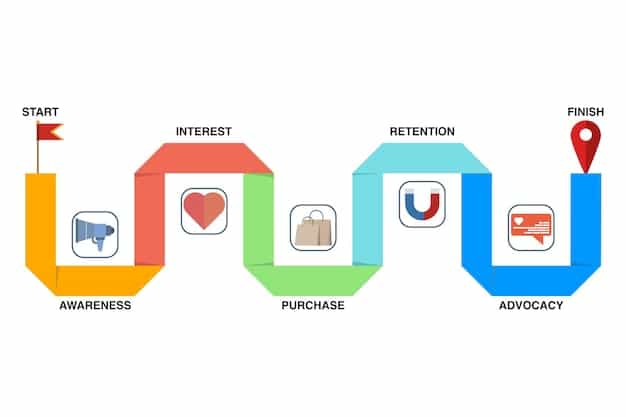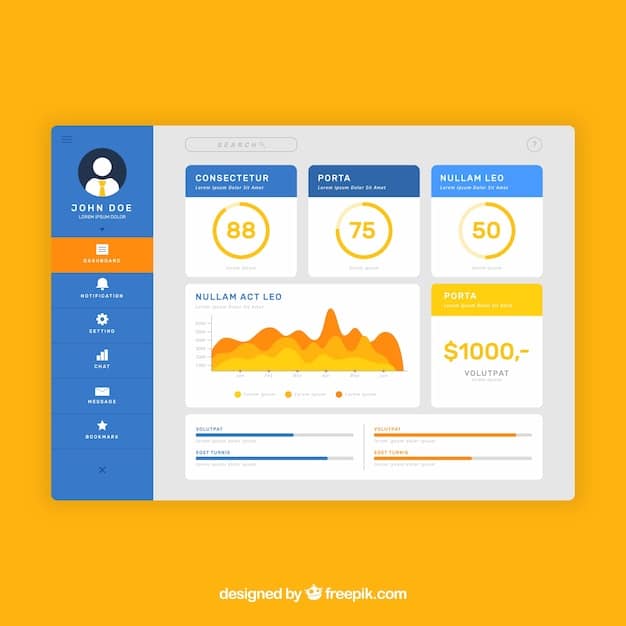The Role of Customer Journey Mapping: Boost Your CX

Customer journey mapping plays a crucial role in identifying pain points and improving customer experience (CX) by visualizing the customer’s interactions with a business across various touchpoints, allowing for targeted improvements and a more satisfying customer journey.
In today’s competitive marketplace, understanding your customer’s experience is paramount. That’s where customer journey mapping comes in. By visualizing your customer’s interactions with your business, you can identify pain points and areas for improvement, ultimately leading to a better customer experience (CX).
Understanding Customer Journey Mapping
Customer journey mapping is the process of creating a visual representation of your customer’s experience with your brand. It outlines the steps a customer takes when interacting with your company, from initial awareness to becoming a loyal advocate. This mapping process helps businesses understand the customer’s perspective and identify opportunities to improve the overall experience.
By stepping into your customer’s shoes, you can gain valuable insights into their needs, expectations, and pain points. This empathetic approach is key to building a customer-centric organization that consistently delivers exceptional experiences.
Benefits of Customer Journey Mapping
Implementing customer journey mapping offers a multitude of benefits for businesses of all sizes. It provides a framework for understanding customer behavior and identifying areas where improvements can be made.
- Identifying Pain Points: Pinpoint the specific moments in the customer journey where customers experience frustration or difficulty.
- Improving Customer Satisfaction: By addressing pain points, businesses can create a more seamless and enjoyable experience, leading to increased customer satisfaction.
- Driving Business Growth: Improved CX translates to increased customer loyalty, positive word-of-mouth, and ultimately, business growth.

Ultimately, customer journey mapping is about more than just fixing problems; it’s about proactively creating a positive and engaging experience for every customer.
Identifying Pain Points Through Mapping
The core purpose of customer journey mapping is to uncover the friction points that customers encounter during their interactions with your brand. These pain points can range from minor annoyances to major obstacles that drive customers away. Effective mapping helps bring these issues to light.
Identifying these pain points is crucial for improving CX and preventing customer churn. By understanding where customers are struggling, you can prioritize efforts to address these issues and create a more positive experience.
Common Customer Pain Points
Customer pain points can manifest in various forms across different stages of the journey. Recognizing these common issues is the first step towards addressing them.
- Difficult Navigation: A website or app that is confusing or difficult to navigate can lead to frustration and abandonment.
- Lack of Information: Customers may struggle to find the information they need, leading to dissatisfaction.
- Poor Customer Service: Unresponsive or unhelpful customer service can quickly turn a customer into a detractor.
By proactively identifying and addressing these pain points, you can significantly improve the overall customer experience and build stronger relationships with your customers.
Mapping and Improving Customer Experience (CX)
Once you’ve mapped the customer journey and identified pain points, the next step is to take action to improve the overall customer experience (CX). This involves implementing changes to address the identified issues and create a more positive and engaging experience for your customers.
Improving CX is an ongoing process that requires continuous monitoring and refinement. By regularly reviewing your customer journey maps and gathering feedback, you can ensure that your CX efforts are aligned with customer needs and expectations.
Strategies for Improving CX
There are various strategies you can employ to improve the customer experience based on the insights gained from your customer journey map.
- Streamline Processes: Simplify complex processes to make it easier for customers to interact with your business.
- Personalize Interactions: Tailor your interactions to meet the individual needs and preferences of each customer.
- Empower Employees: Provide employees with the training and resources they need to deliver exceptional customer service.

Ultimately, the goal is to create a seamless and enjoyable experience for your customers, leading to increased loyalty and advocacy.
Tools Used in Customer Journey Mapping
Creating and managing customer journey maps often requires the use of specialized tools. These tools can help you visualize the customer journey, collect feedback, and track progress on CX initiatives. Selecting the right tools is essential for maximizing the effectiveness of your mapping efforts.
These tools provide valuable insights and facilitate collaboration among team members, ensuring that everyone is aligned on CX goals.
Popular Customer Journey Mapping Tools
A variety of software and platforms are available to assist with customer journey mapping. Each tool offers different features and functionalities to support the mapping process.
- Microsoft Visio: A versatile diagramming tool that can be used to create custom journey maps.
- Miro: A collaborative whiteboard platform that allows teams to work together on journey maps in real-time.
- Lucidchart: A cloud-based diagramming tool specifically designed for creating visual representations of processes and workflows.
Choosing the right tool depends on your specific needs and budget. Consider factors such as ease of use, collaboration features, and integration with other systems.
Implementing a Customer-Centric Approach
Customer journey mapping is most effective when it’s part of a broader customer-centric approach. This means putting the customer at the heart of everything you do, from product development to marketing to customer service. Embracing a customer-centric culture is essential for long-term success.
A customer-centric approach requires a shift in mindset and a commitment to understanding and meeting customer needs at every touchpoint.
Creating a Customer-Centric Culture
Building a customer-centric culture involves fostering a shared understanding of customer needs and empowering employees to make decisions that benefit the customer.
- Gather Customer Feedback: Regularly solicit feedback from customers to understand their experiences and identify areas for improvement.
- Empower Employees: Give employees the autonomy to resolve customer issues and make decisions that enhance the customer experience.
- Recognize and Reward Customer-Centric Behavior: Acknowledge and reward employees who go above and beyond to deliver exceptional customer service.
By embedding customer-centricity into your company’s DNA, you can create a sustainable competitive advantage and build lasting relationships with your customers.
Measuring the Success of CX Initiatives
Measuring the success of your CX initiatives is crucial for demonstrating the value of your efforts and identifying areas where further improvements can be made. Key performance indicators (KPIs) provide valuable insights into the effectiveness of your CX strategy.
Tracking these KPIs over time allows you to monitor progress, identify trends, and make data-driven decisions to optimize your CX initiatives.
Key CX Metrics to Track
Several metrics can be used to measure the success of your CX initiatives. These metrics provide insights into customer satisfaction, loyalty, and advocacy.
- Customer Satisfaction (CSAT): Measures how satisfied customers are with a specific interaction or experience.
- Net Promoter Score (NPS): Measures the likelihood of customers recommending your business to others.
- Customer Effort Score (CES): Measures the effort customers have to expend to interact with your business.
By tracking these and other relevant metrics, you can gain a comprehensive understanding of your CX performance and identify areas for improvement.
| Key Aspect | Brief Description |
|---|---|
| 🔍 Mapping Process | Visualizing the customer’s experience to understand interactions and touchpoints. |
| 🚧 Identifying Pain Points | Pinpointing areas of frustration in the customer’s journey. |
| 📈 Improving CX | Enhancing the overall customer experience through targeted improvements. |
| 📊 Measuring Success | Tracking KPIs to evaluate the effectiveness of CX initiatives. |
Frequently Asked Questions (FAQ)
▼
The first step is to define your customer persona. This involves understanding their demographics, motivations, and goals to create a representative customer profile.
▼
You should update your map regularly, ideally every six to twelve months. Customer behavior and expectations evolve, so keep it current.
▼
Key metrics include Customer Satisfaction (CSAT), Net Promoter Score (NPS), and Customer Effort Score (CES), offering insights into different aspects of CX.
▼
By identifying pain points in the journey, you can uncover opportunities to develop new features or products that address unmet customer needs.
▼
Training empowers employees to deliver exceptional service, resolve issues efficiently, and create positive interactions, which significantly enhances the overall CX.
Conclusion
In conclusion, customer journey mapping is a powerful tool for identifying pain points and improving customer experience. By understanding your customer’s journey and addressing their needs at every touchpoint, you can create a more positive and engaging experience that drives customer loyalty and business growth.





